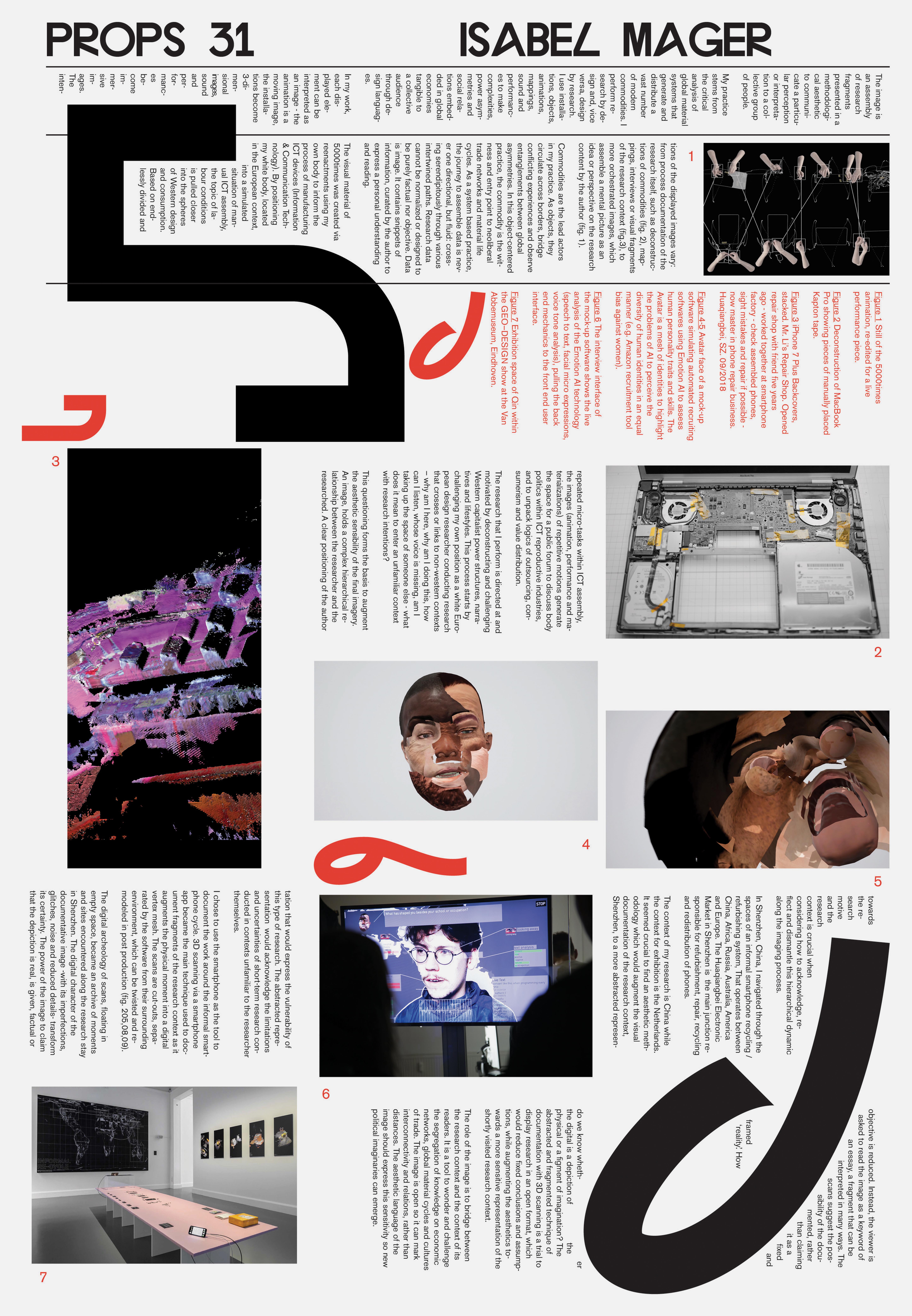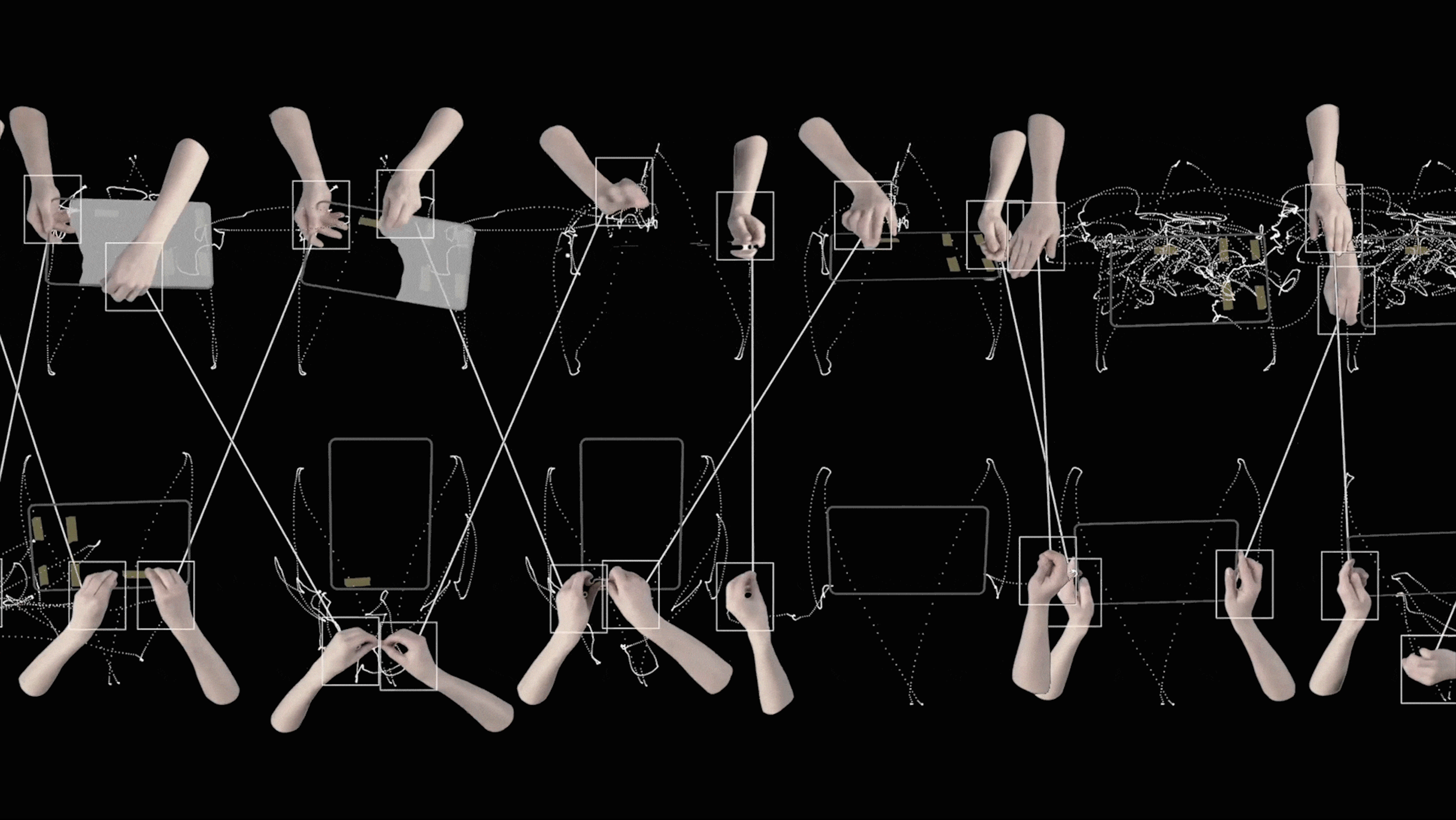

31 IMAGE IS DATA
KIKI MAGER︎︎︎
The image is an assembly of research fragments presented in a methodological aesthetic to communicate a particular perception or interpretation to a collective group of people.
My practice stems from the critical analysis of global material systems that generate and distribute a vast number of modern commodities. I perform research by design and, vice versa, design by research. I use installations, objects, animations, mappings, sound and performances to make complexities, power asymmetries and social relations embedded in global economies tangible to a collective audience through design languages.
In my work, each displayed element can be interpreted as an image - the animation is a moving image, the installations become 3-dimensional images, sound and performances become immersive images. The intentions of the displayed images vary: from process documentation of the research itself, such as![]() , mappings, interviews or
, mappings, interviews or ![]() , to more
, to more ![]() , which assemble a mental picture as an idea or perspective on the research content by the author.
, which assemble a mental picture as an idea or perspective on the research content by the author.
Commodities are the lead actors in my practice. As objects, they circulate across borders, bridge conflicting experiences and observe entanglements between global asymmetries. In this object-centred practice, the commodity is the witness and entry point to neoliberal trade networks and material life cycles. As a system based practice, the journey to assemble data is never one directional, but fluid: crossing serendipitously through various intertwined paths. Research data cannot be normalised or designed to be purely factual nor objective. Data is image. It contains snippets of information, curated by the author to express a personal understanding and reading.
The visual material of 5000times was created via reenactments using my own body to inform the process of manufacturing ICT devices (Information & Communication Technology). By positioning my white body, located in the European context, into a simulated situation of manual ICT assembly, the topic of labour conditions is pulled closer into the spheres of Western design and consumption. Based on endlessly divided and repeated micro-tasks within ICT assembly, the images (animation, performance and materialisations) of repetitive motions generate the space for a public forum to discuss body politics within ICT reproductive industries, and to unpack logics of outsourcing, consumerism and value distribution.
The research that I perform is directed at and motivated by deconstructing and challenging Western capitalist power structures, narratives and lifestyles. This process starts by challenging my own position as a white European design researcher conducting research that crosses or links to non-western contexts – why am I here, why am I doing this, how can I listen, whose voice is missing, am I taking up the space of someone else - what does it mean to enter an unfamiliar context with research intentions? This questioning forms the basis to augment the aesthetic sensibility of the final imagery. An image, holds a complex hierarchical relationship between the researcher and the researched. A clear positioning of the author towards the research motive and the research context is crucial when considering how to acknowledge, reflect and dismantle this hierarchical dynamic along the imaging process.
The image is an assembly of research fragments presented in a methodological aesthetic to communicate a particular perception or interpretation to a collective group of people.
My practice stems from the critical analysis of global material systems that generate and distribute a vast number of modern commodities. I perform research by design and, vice versa, design by research. I use installations, objects, animations, mappings, sound and performances to make complexities, power asymmetries and social relations embedded in global economies tangible to a collective audience through design languages.
In my work, each displayed element can be interpreted as an image - the animation is a moving image, the installations become 3-dimensional images, sound and performances become immersive images. The intentions of the displayed images vary: from process documentation of the research itself, such as
deconstructions of commodities

visual fragments of the research context
orchestrated images

Commodities are the lead actors in my practice. As objects, they circulate across borders, bridge conflicting experiences and observe entanglements between global asymmetries. In this object-centred practice, the commodity is the witness and entry point to neoliberal trade networks and material life cycles. As a system based practice, the journey to assemble data is never one directional, but fluid: crossing serendipitously through various intertwined paths. Research data cannot be normalised or designed to be purely factual nor objective. Data is image. It contains snippets of information, curated by the author to express a personal understanding and reading.
The visual material of 5000times was created via reenactments using my own body to inform the process of manufacturing ICT devices (Information & Communication Technology). By positioning my white body, located in the European context, into a simulated situation of manual ICT assembly, the topic of labour conditions is pulled closer into the spheres of Western design and consumption. Based on endlessly divided and repeated micro-tasks within ICT assembly, the images (animation, performance and materialisations) of repetitive motions generate the space for a public forum to discuss body politics within ICT reproductive industries, and to unpack logics of outsourcing, consumerism and value distribution.
The research that I perform is directed at and motivated by deconstructing and challenging Western capitalist power structures, narratives and lifestyles. This process starts by challenging my own position as a white European design researcher conducting research that crosses or links to non-western contexts – why am I here, why am I doing this, how can I listen, whose voice is missing, am I taking up the space of someone else - what does it mean to enter an unfamiliar context with research intentions? This questioning forms the basis to augment the aesthetic sensibility of the final imagery. An image, holds a complex hierarchical relationship between the researcher and the researched. A clear positioning of the author towards the research motive and the research context is crucial when considering how to acknowledge, reflect and dismantle this hierarchical dynamic along the imaging process.
In Shenzhen, China, I navigated through the spaces of an informal smartphone recycling / refurbishing system, that operates between China, Africa, Russia, Australia, America and Europe. The Huaqiangbei Electronic Market in Shenzhen is the main junction responsible for refurbishment, repair, recycling and redistribution of phones. The context of my research is China while the context for exhibition is the Netherlands. It seemed crucial to find an aesthetic methodology which would augment the visual documentation of the research context, Shenzhen, to a more abstracted representation that would express the vulnerability of this type of research.The abstracted representation would acknowledge the limitations and uncertainties of short-term research conducted in contexts unfamiliar to the researcher themselves.
I chose to use the smartphone as the tool to document the work around the informal smartphone cycle. 3D scanning via a smartphone app became the main technique used to document fragments of the research context as it augments the physical moment into a digital vertex mesh. The scans are
cut-outs
The digital archeology of scans, floating in empty space, became an archive of moments and sites encountered along the research stay in Shenzhen. The digital character of the documentative image — with its imperfections, glitches, noise and reduced details — transform its certainty. The power of the image to claim that the depiction is real, is given, factual or objective is reduced. Instead, the viewer is asked to read the image as a keyword of an essay, a fragment that can be interpreted in many ways. The scans suggest the possibility of the documented, rather than claiming it as a fixed and framed ‘reality.’ How do we know whether the digital is a depiction of the physical or a figment of imagination? The abstracted and fragmented technique of documentation with 3D scanning is a trial to display research in an open format, which would reduce fixed conclusions and assumptions, while augmenting the aesthetics towards a more sensitive representation of the shortly visited research context.
The role of the image is to bridge between the research context and the context of its readers. It is a tool to wonder and challenge the segregation of knowledge on economic networks, global material cycles and cultures of trade. The image is open so it can mark interconnectivity and relations, rather than distances. The aesthetic language of the image should express this sensitivity so new political imaginaries can emerge.
KIKI MAGER︎︎︎ is an investigative designer whose work confronts an oscillation between design culture and structures of power. Mager’s most recent work dissects complexities of mass material culture; infrastructure, access and invisible forms of labour. The work critically analyses and maps these underlying mechanisms and translates these in a physical and visual way. The work takes the form of installations, prototypes, performances and articles within a design and academic context. Mager is the current holder of a Talent Development Grant from the Creative Industries NL and a resident at the Inside-Out Art Museum Beijing. Mager was a Global Graduate speaker for the Design Indaba Festival (Cape Town, ZA, 2017), a a collaborative grant holder with designer Gabriel Maher at the IASPIS international residency programme (Stockholm, SE). Mager presented at the Intersectional Perspectives on Design, Politics and Power symposium in Malmö (SE) by Decolonising Design. 5000times Exploitative Mechanisms was published through Decolonising Design Journal. Mager received a BA Cum Laude at the Design Academy Eindhoven (2016, NL).
PROPS PAPER 31 was printed with KIKI’s former name, Isabel Mager.
PROPS PAPER 31 was printed with KIKI’s former name, Isabel Mager.